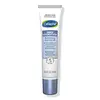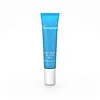What's inside
What's inside
 Key Ingredients
Key Ingredients

 Benefits
Benefits

 Concerns
Concerns

 Ingredients Side-by-side
Ingredients Side-by-side

Water
Skin ConditioningDicaprylyl Carbonate
Emollient1,2-Hexanediol
Skin ConditioningPolyglyceryl-6 Distearate
EmulsifyingDistarch Phosphate
Absorbent4-T-Butylcyclohexanol
MaskingAcrylates/C10-30 Alkyl Acrylate Crosspolymer
Emulsion StabilisingAnhydroxylitol
HumectantBisabolol
MaskingCaprylyl/Capryl Glucoside
CleansingCetyl Alcohol
EmollientCitric Acid
BufferingDunaliella Salina Extract
Skin ConditioningEthylhexylglycerin
Skin ConditioningGlobularia Alypum Leaf Extract
Skin ConditioningHydrolyzed Hyaluronic Acid
HumectantJojoba Esters
EmollientPalmitoyl Tripeptide-5
Skin ConditioningPanthenol
Skin ConditioningPantolactone
HumectantPentylene Glycol
Skin ConditioningPhenoxyethanol
PreservativePolyglyceryl-3 Beeswax
EmulsifyingPolyisobutene
Potassium Sorbate
PreservativeSodium Acrylate/Sodium Acryloyldimethyl Taurate Copolymer
Emulsion StabilisingSodium Benzoate
MaskingSodium Hyaluronate
HumectantSodium Hydroxide
BufferingSodium PCA
HumectantSorbitan Oleate
EmulsifyingTocopherol
AntioxidantXylitol
HumectantXylitylglucoside
HumectantWater, Dicaprylyl Carbonate, 1,2-Hexanediol, Polyglyceryl-6 Distearate, Distarch Phosphate, 4-T-Butylcyclohexanol, Acrylates/C10-30 Alkyl Acrylate Crosspolymer, Anhydroxylitol, Bisabolol, Caprylyl/Capryl Glucoside, Cetyl Alcohol, Citric Acid, Dunaliella Salina Extract, Ethylhexylglycerin, Globularia Alypum Leaf Extract, Hydrolyzed Hyaluronic Acid, Jojoba Esters, Palmitoyl Tripeptide-5, Panthenol, Pantolactone, Pentylene Glycol, Phenoxyethanol, Polyglyceryl-3 Beeswax, Polyisobutene, Potassium Sorbate, Sodium Acrylate/Sodium Acryloyldimethyl Taurate Copolymer, Sodium Benzoate, Sodium Hyaluronate, Sodium Hydroxide, Sodium PCA, Sorbitan Oleate, Tocopherol, Xylitol, Xylitylglucoside
Water
Skin ConditioningDimethicone
EmollientGlycerin
HumectantCetearyl Olivate
Sorbitan Olivate
EmulsifyingPolyacrylamide
Phenoxyethanol
PreservativeDimethicone/Vinyl Dimethicone Crosspolymer
Skin ConditioningSynthetic Beeswax
Emulsion StabilisingC13-14 Isoparaffin
EmollientDimethicone Crosspolymer
Emulsion StabilisingCarbomer
Emulsion StabilisingTrehalose
HumectantDimethiconol
EmollientChlorphenesin
AntimicrobialLaureth-7
EmulsifyingSodium Hyaluronate
HumectantEthylhexylglycerin
Skin ConditioningSodium Hydroxide
BufferingC12-14 Pareth-12
EmulsifyingWater, Dimethicone, Glycerin, Cetearyl Olivate, Sorbitan Olivate, Polyacrylamide, Phenoxyethanol, Dimethicone/Vinyl Dimethicone Crosspolymer, Synthetic Beeswax, C13-14 Isoparaffin, Dimethicone Crosspolymer, Carbomer, Trehalose, Dimethiconol, Chlorphenesin, Laureth-7, Sodium Hyaluronate, Ethylhexylglycerin, Sodium Hydroxide, C12-14 Pareth-12
 Reviews
Reviews

Ingredients Explained
These ingredients are found in both products.
Ingredients higher up in an ingredient list are typically present in a larger amount.
Ethylhexylglycerin (we can't pronounce this either) is commonly used as a preservative and skin softener. It is derived from glyceryl.
You might see Ethylhexylglycerin often paired with other preservatives such as phenoxyethanol. Ethylhexylglycerin has been found to increase the effectiveness of these other preservatives.
Phenoxyethanol is a preservative that has germicide, antimicrobial, and aromatic properties. Studies show that phenoxyethanol can prevent microbial growth. By itself, it has a scent that is similar to that of a rose.
It's often used in formulations along with Caprylyl Glycol to preserve the shelf life of products.
Sodium Hyaluronate is hyaluronic acid's salt form. It is commonly derived from the sodium salt of hyaluronic acid.
Like hyaluronic acid, it is great at holding water and acts as a humectant. This makes it a great skin hydrating ingredient.
Sodium Hyaluronate is naturally occurring in our bodies and is mostly found in eye fluid and joints.
These are some other common types of Hyaluronic Acid:
Learn more about Sodium HyaluronateSodium Hydroxide is also known as lye or caustic soda. It is used to adjust the pH of products; many ingredients require a specific pH to be effective.
In small amounts, sodium hydroxide is considered safe to use. However, large amounts may cause chemical burns due to its high alkaline.
Your skin has a natural pH and acid mantle. This acid mantle helps prevent harmful bacteria from breaking through. The acid mantle also helps keep your skin hydrated.
"Alkaline" refers to a high pH level. A low pH level would be considered acidic.
Learn more about Sodium HydroxideWater. It's the most common cosmetic ingredient of all. You'll usually see it at the top of ingredient lists, meaning that it makes up the largest part of the product.
So why is it so popular? Water most often acts as a solvent - this means that it helps dissolve other ingredients into the formulation.
You'll also recognize water as that liquid we all need to stay alive. If you see this, drink a glass of water. Stay hydrated!
Learn more about Water